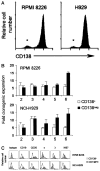Characterization of clonogenic multiple myeloma cells
- PMID: 14630803
- PMCID: PMC3311914
- DOI: 10.1182/blood-2003-09-3064
Characterization of clonogenic multiple myeloma cells
Abstract
The identity of the cells responsible for the initiation and maintenance of multiple myeloma (MM) remains unclear largely because of the difficulty growing MM cells in vitro and in vivo. MM cell lines and clinical specimens are characterized by malignant plasma cells that express the cell surface antigen syndecan-1 (CD138); however, CD138 expression is limited to terminally differentiated plasma cells during B-cell development. Moreover, circulating B cells that are clonally related to MM plasma cells have been reported in some patients with MM. We found that human MM cell lines contained small (< 5%) subpopulations that lacked CD138 expression and had greater clonogenic potential in vitro than corresponding CD138+ plasma cells. CD138- cells from clinical MM samples were similarly clonogenic both in vitro and in nonobese diabetic/severe combined immunodeficiency (NOD/SCID) mice, whereas CD138+ cells were not. Furthermore, CD138- cells from both cell lines and clinical samples phenotypically resembled postgerminal center B cells, and their clonogenic growth was inhibited by the anti-CD20 monoclonal antibody rituximab. These data suggest that MM "stem cells" are CD138- B cells with the ability to replicate and subsequently differentiate into malignant CD138+ plasma cells.
Figures





References
-
- Drewinko B, Alexanian R, Boyer H, Barlogie B, Rubinow SI. The growth fraction of human myeloma cells. Blood. 1981;57:333–338. - PubMed
-
- Pilarski LM, Jensen GS. Monoclonal circulating B cells in multiple myeloma: a continuously differentiating, possibly invasive, population as defined by expression of CD45 isoforms and adhesion molecules. Hematol Oncol Clin North Am. 1992;6:297–322. - PubMed
-
- Bakkus MH, Van RI, Van Camp B, Thielemans K. Evidence that the clonogenic cell in multiple myeloma originates from a pre-switched but somatically mutated B cell. Br J Haematol. 1994;87:68–74. - PubMed
Publication types
MeSH terms
Substances
Grants and funding
LinkOut - more resources
Full Text Sources
Other Literature Sources
Medical
Miscellaneous

